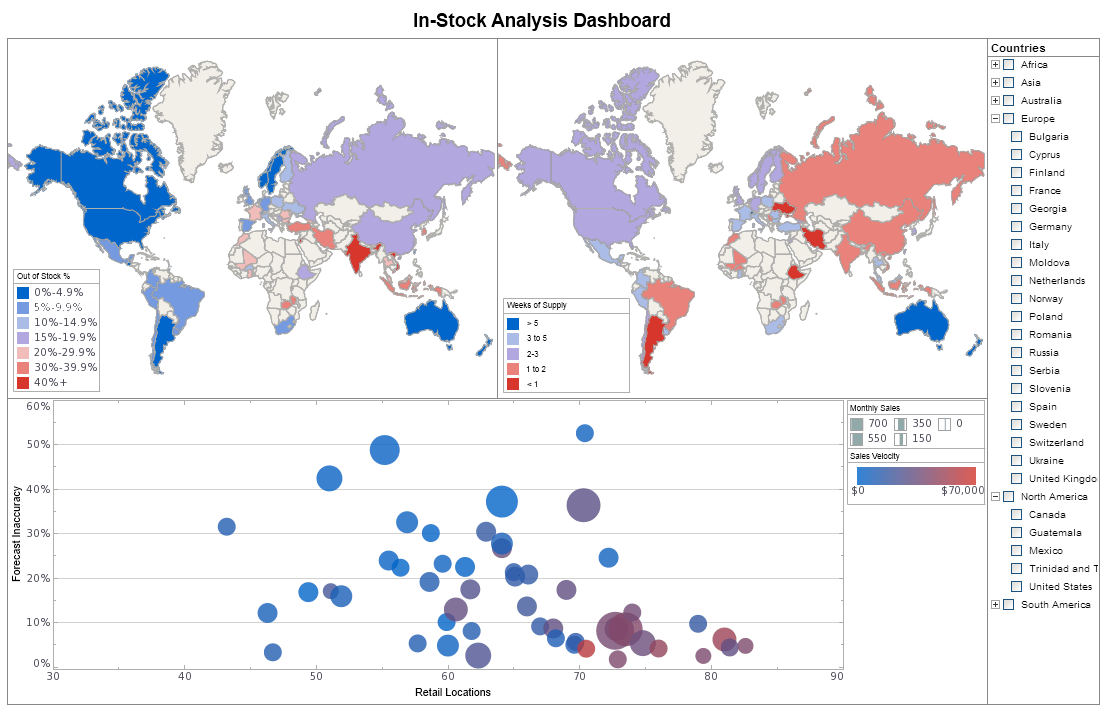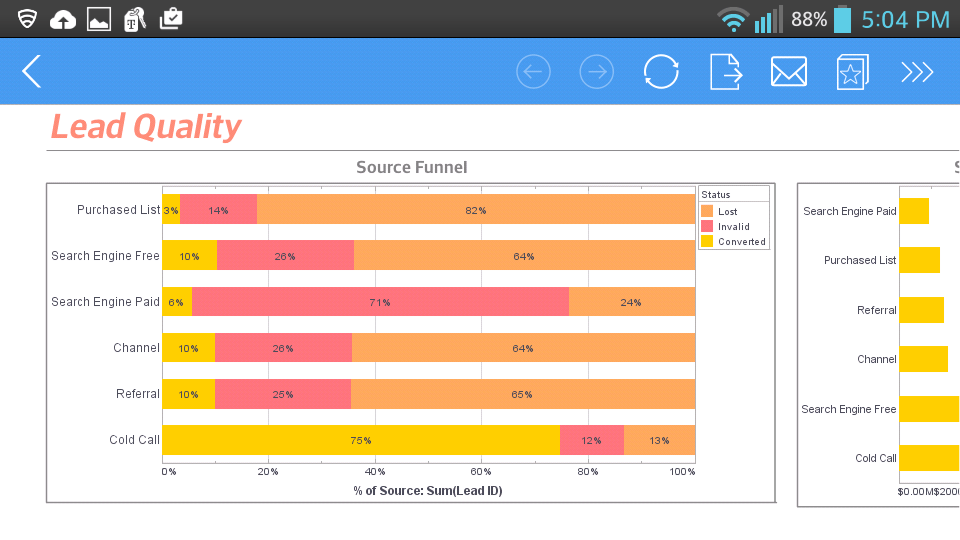Embedded Business Intelligence - InetSoft Technology
Business is an ever evolving field. As technology gets more sophisticated and the times change, businesses must adapt. They must not only adapt the way they conduct their business, however, but also the way they track it. Today, there exists three categories of business intelligence software: standalone, integrated, and embedded.
Business intelligence software has been around for a while. In fact, Microsoft Excel is technically a type of business intelligence software. Excel operates with only limited access to a data warehouse that must constantly be updated. This places it in the standalone BI category. Standalone BI applications require highly trained power users to conceptualize advanced formulae to manipulate and track data.
Integrated BI software is a step up from the standalone programs. These programs are slightly more user friendly, allowing themselves to be merged (integrated) with another application to analyze data. These utilities still operate off a static data warehouse and typically require an external BI server process to function.
Embedded BI is the most seamless. Applications in this category operate with access to real-time data stores. They allow users to report and analyze data without leaving the application they use every day. For example, a CRM application where the embedded dashboard displays the daily number of new leads created, or a financial management application that provides immediate drill-through reporting would fall under this category.
 |
View a 2-minute demonstration of InetSoft's easy, agile, and robust BI software. |
InetSoft's Embedded BI Software
InetSoft's SOA and Java architecture, small footprint, and open standards-based technology makes embedding BI easy. Because of the architecture's 'componentized' nature, there are numerous approaches that can be used for embedding and integration, including:
- Single sign-on and out-of-box LDAP integration
- Web service and SOAP architecture
- CSS driven presentation customization
- Componentized portal
- JSP tag library for presentation
- IIS and MS Share Point integration-ready
- Java API for data and report manipulation
Web applications can embed our engine to render production reports. Key benefits include the ability to:
- Reduce data query and manipulation complexity
- Deliver high fidelity, professional quality presentation
- Leverage standard skills – XML, JavaScript and Java
- Reduce report maintenance and management cost
Web applications can call our servlet, or Web Services to create seamless integration with minimal coding. It enables business users to gain access to application data with more freedom. Key benefits include the ability to:
- Maximize dashboard and report value by leveraging native interactivity
- Extend data access through ad hoc reports
- Serve many users by exploiting our scalability
Unlimited embedding possibilities exist with InetSoft BI technology that will accommodate the most demanding integration requirements.
 |
Read why choosing InetSoft's cloud-flexible BI provides advantages over other BI options. |
What KPIs, Metrics, and Charts Would a Developer of Corrective and Preventive Action Software Include When Embedding a BI Application?
Corrective and Preventive Action (CAPA) software is designed to help organizations manage and track the resolution of issues and incidents, as well as to implement measures to prevent their recurrence. The key performance indicators (KPIs), metrics, and charts displayed in CAPA software typically focus on various aspects of the corrective and preventive action process. Here are some examples:
- Number of CAPA Requests:
- This metric tracks the total number of CAPA requests initiated within a specific period. It provides an overview of the volume of issues and incidents being addressed by the organization.
- CAPA Cycle Time:
- Measures the time taken from the initiation of a CAPA request to its closure. It helps assess the efficiency of the corrective and preventive action process and identify bottlenecks that may prolong resolution times.
- Root Cause Analysis Effectiveness:
- Evaluates the effectiveness of identifying root causes of issues or incidents. It may include metrics such as the percentage of CAPAs with clearly defined root causes or the percentage of CAPAs where root causes were accurately addressed.
- CAPA Closure Rate:
- Tracks the percentage of CAPA requests that have been successfully closed within a defined timeframe. It indicates the organization's ability to implement corrective and preventive measures in a timely manner.
- Trend Analysis:
- Charts depicting trends in the number of CAPA requests over time can help identify patterns or recurring issues that require attention. Trend analysis may also include charts showing the distribution of CAPAs by severity or department.
- Cost of Quality Improvement:
- Calculates the cost incurred by the organization to implement corrective and preventive actions, including labor, materials, and any associated expenses. This metric helps assess the return on investment (ROI) of quality improvement efforts.
- Effectiveness of Corrective Actions:
- Measures the effectiveness of implemented corrective actions in preventing the recurrence of similar issues. It may include metrics such as the percentage of CAPAs with no recurrence or the average time between recurrence of similar issues.
- Preventive Action Implementation Rate:
- Tracks the percentage of CAPA requests that result in the implementation of preventive actions aimed at addressing potential issues before they occur. It reflects the organization's proactive approach to quality management.
Charts commonly displayed in CAPA software include:
- Bar Charts: Showing the distribution of CAPA requests by category, department, or severity.
- Trend Lines: Illustrating trends in the number of CAPA requests over time.
- Pie Charts: Representing the proportion of CAPAs by root cause or status (open, in progress, closed).
- Histograms: Displaying the distribution of CAPA cycle times or cost of quality improvement.
More Resources About Embedding
Dashboard Selection Container Components - A Selection Container can hold Selection List and Range Slider components. To add selection components to a Selection Container, follow the steps below: 1. Drag a Selection Container component from the Component tree onto the Viewsheet grid. This creates an empty Selection Container element. 2. Drag a data field onto the Selection Container. (Use the green highlight to place the field as desired.) You can obtain this field from two sources...
Flexible Charts & Tables for Google Sheets - Charts are the easiest to understand visualization tool, and InetSoft offers many choices. Tables, as spreadsheets have demonstrated, can pack information in their special ways. InetSoft offers extremely flexible tables that can embed sophisticated inter-cell calculations...
Product How-To: Creating Parameretized Reports - While simple replets such as the one in the previous example are very useful, the replet API enables the building of much more powerful and flexible replets. An important concept is that of parameterized reports. Parameterized reports allow the replet to collect user input before or after report creation. It is up to the replet to use the parameter values to customize the final report...
Three Database Dashboard Examples - Dashboards offer companies various ways of representing their data. From sales projections, to employee statistics, and even inventory stock, database dashboards are able to easily represent all of the numerical data that your company can hold, into a visually appealing dashboard...





